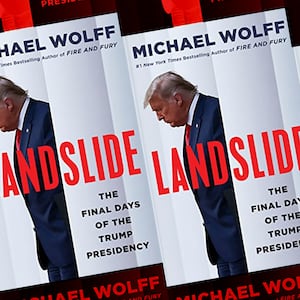The thing about these yuge Trump books dropping now is that, unlike the ones that appeared in 2017, they’re not only re-telling a story we just lived through, but one that was widely understood as it happened as a chronicle of an inept and overwhelmed administration. In Trump’s final year, there were fewer and fewer alleged “adults in the room” to watch over a crew of climbers and toadies more or less making it up as they went along in service of an emotionally mercurial, morally crass, and intellectually limited president—who, despite all that, lost narrowly enough, in his mind at least, to deny that reality and could easily have not lost at all if events had played out a little differently.
These accounts will be valuable to historians, but tearing through these books right now feels an awful lot like binge-watching a show that you’d just finished binge watching.
And a show is certainly how Trump saw it. At the end of Carol Leonnig and Philip Rucker’s thorough and well-framed new book, I Alone Can Fix It, which The Daily Beast obtained ahead of its release next week, Trump sits down with the authors for an exit interview of sorts while holding court at Mar-a-Lago—which, as it happens, is the same way that Michael Wolff closes his sometimes overlapping (presumably in part because their sources overlap) and much thinner account of the same events, Landslide.
In his I Alone exit interview, the 45th president goes from trashing Doctors Anthony Fauci (“a highly overrated person”) and Deborah Birx (“A real diva with the scarves and shit”) to boasting that “You have people that have never been stars before and all of a sudden The Washington Post is calling, New York Times is calling. CNN would love to have lunch with you. You are a regular person” who wouldn’t be getting these calls in the Carter or Bush administration, he continues, but “With Trump, everybody becomes a star. I’m the greatest star-maker in history.”
And when you’re a star, I hear, they let you do it, even when doing it is spilling tea to the Washington Post or The Daily Beast or a book author about the administration you’ve worked in and how dumb and dysfunctional everyone else was. Trump has a second point he was trying to make with that boast, Leonnig and Rucker write:
“The incredible excitement of his administration, he said, drove media interest in chronicling disputes and differences of opinion among his staff, creating a false impression that his administration was chaotic.”
Of course, the reporters paraphrasing Trump there are among those chroniclers of the “incredible excitement,” both in their day-jobs breaking news for the Post and their side hustle writing a second hefty tome now adding narrative detail to that news about the chaos that’s clearly not false but has perhaps been exaggerated, since that’s what the “stars” need to give to be that and what the audience demands. There’s a reason these new books, which are not revelatory accounts of people in power but first drafts of history, are bestsellers even before they hit the shelves.
That could have been very different if not for the coronavirus. Trump’s internal polling in February matched public surveys showing he was in a strong position to win a second term with his impeachment trial behind him, a massive campaign war chest and the economy booming.
“Just don’t make a mistake and we’ve got this in the bag,” Brad Parscale tells him. Talking to the authors at Mar-a-Lago, Trump seems to endorse this view, lamenting that “In a certain way, I had two presidencies” thanks to the pandemic and his flailing public response to it, even as he helped push through vaccines in record time, albeit ones that arrived to his fury just after the election.
February was the same month that Xi Jinping dismissed Trump’s offer to bring Americans from the CDC to Wuhan, brushing him off while telling him “We’re waging a people’s war against this virus. It’s going to be contained in short order.” Xi also told him that the coronavirus was “easily defeated” by warmer weather, a false claim that Trump would repeat throughout the spring as he went on about how the pandemic would "go away like things go away."
When Trump finally puts Vice President Mike Pence in charge of the virus response later in the month, after the virus has arrived here and the markets have tumbled, he chose his veep because “He didn’t have anything else to do,” first son-in-law Jared Kushner tells Health Secretary Alex Azar later in February, according to I Alone. (An administration spokesperson told the authors that Kushner didn’t recall saying that.)
I Alone is full of self-certified adults, and presumed sources, talking about the good advice they gave Trump that he didn’t take.
In March, Chris Christie in effect advises Trump to be Andrew Cuomo:
“There is a way to handle a crisis where you meet people’s expectations of how the crisis is playing out… The way to do that is they expect you to be out there. They expect you to prove to them that you understand why they’re afraid and that no matter how long it takes you’re going to fix the problem.
“But you’re not doing that… You’re telling people that it’s just going to go away, it’s going to magically go away. People don’t want to hear that. You tell people that we’ve got it under control, but it’s clear we don’t, and so I’m very concerned that what you’re doing is you’re setting yourself up for a failure and that people will not believe you after a while.”
And in April, Barr counsels him that “I feel like you are going to lose the election… I feel like you are actually losing touch with your own base…
“I have yet to meet anybody who supports you who hasn’t said to me, ‘We love the president, but would you please tell him to turn it back a bit?’… You are going to lose because there’s going to be enough people who otherwise would vote for you who are just tired of the acrimony, the pettiness, the punching down and picking a fight at every moment, and the apparent chaos, and they’re just going to say, ‘We’re tired of this shit.’…
“I think that if you wanted to you could walk into a second term, COVID and all. You could go down in history as an amazing president, and it’s yours for the taking. But it’s about you, and you’re turning off enough people to lose the election.”
Those conversations were presumably recollected with the benefit of hindsight. But here’s what Mitt Romney told the I Alone authors in September, and that’s hard to read without shuddering now:
“When I heard him say, if I lose to Joe Biden, the worst candidate in the history of the earth, it will be because the election is ‘rigged,’ I just presumed that’s in the category of something he’s going to say to himself and a few other people will believe him and he’ll therefore be comfortable at Mar-a Lago with himself and with his ego in the event he loses.”
So when Trump wouldn’t commit to a peaceful transfer of power even before the election, Romney continued, “I thought to myself, oh, he thinks that if he participants in a transition that he’s going to get jinxed and might mean he would lose and that he has to make sure that he doesn’t do anything that suggests he can do anything but win… I marked it up to his psyche, but recognized that this comes at a cost in the event he loses.”
Quite a cost, we know now.
On Jan. 7, Liz Cheney, then the number three Republican in the House before her subsequent demotion for recognizing what Romney did not, recalled what had happened on Jan. 6. Talking with Joint Chief of Staff Chair Mark Milley, who is one of the adults in the room who Leonnig and Rucker depend on in their reporting and cast as something of a hero, Cheney ripped into “That fucking guy Jim Jordan. That son of a bitch… While these maniacs are going through the place, I’m standing in the aisle and he said ‘We need to get the ladies away from the aisle. Let me help you.’ I smacked his hand away and told him, ‘Get away from me. You fucking did this.’”
Trump, too. Looking back from Mar-a-Lago, where everyone applauds when he rises from his interview and walks to the balcony, he summed things up in his inimitable way:
“(W)e have a base like no other. They’re very angry. That’s what happened in Washington on the sixth… I’ll bet you it was over a million people… Many, many people have told me that was a loving crowd. It was too bad, it was too bad that they did that.”
—Harry Siegel.
Wall Street Journal reporter Michael Bender’s Frankly, We Did With This Election: The Inside Story of How Trump Lost is a juicy warts-and-all look at Donald Trump’s failed reelection campaign.
The book covers the time from Trump’s first impeachment in December 2019 to his second acquittal in February 2021, relying on hundreds of interviews with 150 Trump world insiders to present a fascinating portrait of the chaos of the administration and how people around Trump genuinely feared for the safety of the country because the president had become so unglued.
Bender, who covered Trump from the 2016 election through the 2020 election and has interviewed the former president multiple times, peppers his book with vignettes from Trump supporters delivering context and insight as to why his diehard fans never wavered in their support for him.
“The whole place is erupting, everyone is screaming, and your heart is beating like, just, oh my God,” Trump junkie Saundra Kiscenzki explains to Bender about attending his rallies. “It’s like nothing I’ve experienced in my lifetime.”
The book chronicles the build-up to Trump running for president from his relentless use of the Obama birther conspiracy as a device to attract supporters and how he weaponized Fox News to push the false narrative that his supporters lapped up.
‘Behind the scenes in Trump Tower, the birtherism issue was too controversial even for (Roger) Stone,’ Bender writes. ‘He had warned Trump that he would be viewed as a racist.
“The established media is going to destroy you, because it’s going to look like race baiting,” Stone told him. “It’s not race baiting,” Trump objected. “He’s either eligible, or he’s not eligible.”
One of the most amusing anecdotes comes when Bender recounts how Jared Kushner and Ivanka Trump were in a state of confusion when in February 2016 they couple arrived at a hotel in Cedar Rapids for the Iowa caucus.
“As Iowans approached and asked about caucusing for Trump, the two New Yorkers traded blank stares,” Bender reports. “Ivanka had recorded a how‐to‐caucus video for the campaign a few days earlier, but she’d read the instructions from a script. She asked Jared if he knew what to do. “I have no idea,” Jared told his wife. He pulled out his phone, opened a web browser, and typed out one letter at a time: H‐o‐w d‐o y‐o‐u c‐a‐u‐c‐u‐s?”
Bender is at his best when he goes inside his own newsroom to the final days of the 2020 campaign when dirty tricks were the game the Trump campaign was playing in an effort to smear Hunter Biden and falsely claim his father Joe had been profiteering off his son using the family name to make money. In a chapter titled “Where’s Hunter?” the book lays out how a group of Trump loyalists including Rudy Giuliani, Arthur Schwartz, and Steve Bannon used the contents of a laptop purportedly left by Hunter at a computer repair show as part of a failed “October surprise.”
“These Trump loyalists, it turned out, were desperate for the imprimatur of the Journal on any story about Hunter Biden’s dealings,” Bender writes. ”For the past two years, mainstream media outlets, including the Journal and others, had found little more than innuendo, much less illegality, when it came to Joe Biden’s involvement in Hunter’s pursuits. They feared that providing these documents to a friendly publication like Breitbart or the New York Post would only create the same doubts about the legitimacy of the story.”
Ultimately the laptop story would indeed be splashed across the pages of the New York Post but did nothing to advance Trump’s reelection hopes.
Some of the most shocking revelations in the book center around Gen. Mark Milley, chairman of the Joint Chiefs of Staff, and his repeated clashes with Trump and others around him over how to handle the protests that rocked the country following the murder of George Floyd.
In several instances Milley talks Trump off the ledge when he wants to send military troops into major American cities to end the social unrest.
In one tense exchange in the Oval Office Stephen Miller tells Milley, “These cities are burning.”
Bender writes that the remark infuriated the four‐star Army general, who forced Trump to reconsider his position.
“No, Mr. President, they’re not burning the cities,” Milley said according to the book.
“Milley spotted President Lincoln’s portrait hanging just to the right of Trump and pointed directly at it,” Bender writes.
“That guy had an insurrection,” Milley said. “What we have, Mr. President, is a protest.”
—Lachlan Cartwright.
There is a subgenre of detective fiction called police procedurals, such as Ed McBain’s 87th Precinct novels and Georges Simenon’s Inspector Maigret series. There is often no mystery in these stories, no whodunit. Rather, the story follows police detectives through a case step by step to the solution of a crime. So think of Nightmare Scenario: Inside the Trump Administration’s Response to the Pandemic That Changed History, by Washington Post reporters Yasmeen Abutaleb and Damian Paletta, as a procedural and the ineptness and stupidity they reveal as the crime. The crucial, tragic difference, of course, is that Nightmare Scenario is not fiction.
The book doesn’t break a lot of news. What it provides instead is some very welcome depth and nuanced detail to events we only thought we knew. When Trump contracted COVID, for example, we knew he was ill enough to be hospitalized but few people knew at the time just how close to death he came. But the truly revelatory moment in the authors’ account of Trump’s illness is from the point of view of CDC director Robert Redfield as he watches Trump return from the hospital in October 2020. Even then, Redfield hoped against hope that Trump would seize the chance to tell people to take the virus seriously. But that was to imagine that Trump was someone he was not, and Redfield saw his hope smashed as soon as Trump reached the White House and defiantly tore away his mask.
This moment is not in and of itself greatly important, but it becomes important, as the authors show, when it’s fitted into a troubling and ultimately terrifying pattern. This idea of missed chances and lost opportunities crops up over and over, as when, in March, the White House pondered, oh so briefly, sending masks to every household in the country. But no, here as elsewhere, from the moment the virus reached our shores, Trump and his enablers would make one wrong choice after another. Indeed, about the only thing they got right was Operation Warp Speed, the program to develop and deliver a vaccine in record time, and even then success was achieved mostly in spite of the White House. “The whole pandemic response was managed through power, intimidation, and bullying,” the authors write with admirable understatement.
The best thing about Nightmare Scenario is that it gives its readers a narrative, a day by day and month by month account that helps make sense of the story that we experienced and struggled to comprehend as it was happening. OK, maybe not “make sense” so much as it helps find a path through the chaos.
Even though we know how it all ends, we read with a grim, can’t-turn-away fascination as we watch things go from bad to worse to Scott Atlas. Every chapter begins with a date and two figures: the number of recorded cases and the number of deaths. Chapter One begins with 2 cases and 0 deaths as of January 2020. By the last chapter, nine months later, the case figure is 9 million and the death toll is 229,293. At the end of that chapter, in January 2021, the deaths have climbed to over 400,000.
This makes it easy, for instance, to know that when a petulant, bored Trump wanted to reignite his rallies and traipsed off to an indoor arena in Tulsa, where he would first drop his noxious “Kung flu” bomb, there were 2,100,000 confirmed cases and 116,000 deaths. This was the rally where a famously tiny crowd of 6,200 people heard Trump say that he had told his aides to scale back testing so the case numbers wouldn’t be so high: “When you do testing to that extent, you’re going to find more people, you’re going to find more cases. So I said to my people, ‘Slow the testing down, please!” It might have sounded like a joke, but as Abutaleb and Paletta point out, Trump repeatedly complained about testing to his staff, borne along by the insane logic that if you didn’t have testing, you wouldn’t have numbers, and if you didn’t have numbers, you wouldn’t have a pandemic.
The further I read in Nightmare Scenario, the angrier I got, and that surprised me because I did not think I had the capacity to be angered any longer by this endless shitshow. But when you see it all pulled together like this, when you are shown example upon example of the mendacity and cynicism of a White House that always, always prioritized Trump’s whims and vanity (he thought masks made him look weak) and allowed political imperatives to shove aside any thought of public welfare (“What happens when you mix politics and public health?” one administration official said. “You get politics.”), it makes you think, this is not mere stupidity, this is outright evil.
No one was ever going to concoct a perfect response to COVID-19, and certainly not in a country as sprawling and unruly as this one. But even a little competence, not to mention compassion, would have been enough to avert many needless deaths. When historians study this event a century from now, they will use books like this one and the others on the pandemic year as textbooks of how to do everything exactly the wrong way.
—Malcolm Jones



